|
Design by Chris Ostlind- Salt Lake City, Utah - USA |
The skinny little girl grows up
A64 SPECIFICATIONS: |
LOA |
- |
21’ |
BOA (vaka hull) |
- |
34.5” |
BOA (trailer width) |
- |
7’ 8” |
BOA (complete boat) |
- |
9’ 10” |
LWL |
- |
20’ 8” |
BWL |
- |
29” |
Displacement |
- |
800 lbs. |
Prismatic Coefficient |
- |
.54 |
Sail Area |
- |
103 sq. ft. |
Main |
- |
70 sq. ft. |
Mizzen |
- |
33 sq. ft. |
Weight |
- |
225 lbs. |
I recently had a friend in Sweden ask me to design a new boat for he and his lovely wife. The new boat needed to take them on sailing and paddling adventures on lakes, as well as coastal cruising on the waters near their home on the West Coast of Sweden.
 |
I recently had a friend in Sweden ask me to design a new boat for he and his lovely wife.
(click images for larger views) |
|
They asked for a boat with a single outrigger that could be car-topped by two healthy adults. It wasn’t important that the boat be especially fast, so a big sail rig wasn’t necessary. My friend is partial to rigs with traditional style and specified a Lug rigged yawl as his preference. The boat had to have the displacement potential for a well-equipped camping and cruising scenario that would last for extended weekends on the water. They also preferred the keel form to be a leeboard so the interior of the hull could be open for sleeping for the two of them.
Oh… and I needed to design it for a stitch and glue build style in marine plywood.
So, with my marching orders in hand, I started looking around for other examples of this type of boat that could serves as an inspiration or provoke ideas that offered powerful solutions. I quickly scanned through my herd of multihull links and almost immediately, the design of Joe Henry’s truly sweet, Flaquita
exploded on my computer screen. I’d always liked the compact beauty and well thought-out utility of Flaquita and here I found myself about to draw my own, expanded interpretation of the design.
It’s no secret that designers have been pilfering each other’s design cues for as long as man has been building boats. Far from being offended by the process, I find that it’s the very essence of the pilfering that allows for new ideas to be incorporated. These incorporations, in turn, have the potential to improve the usefulness, the performance and the strength of the boats so that everyone benefits.
The A64 (6.4 meters in length) is something of a continuation of some of my ideas in the previously designed and built, A18 performance canoe/trimaran. While the A64 is primarily a sailing boat, there are very strong, retained design concepts from a paddled craft so that the owners can easily paddle the boat in very thin water when there’s no wind about or they need to maneuver precisely in a confined space.
| It’s no secret that designers have been pilfering each other’s design cues for as long as man has been building boats. |
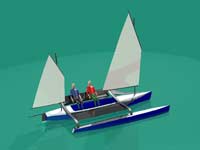
|
|
Vaka Hull
The boat is basically a narrow hulled canoe form that is designed to optimize the displacement requirements while providing the least amount of wetted surface. The prismatic coefficient of the canoe hull is set to .54 to allow the boat to accelerate easily in light winds and be efficient at the lower speeds that it will typically be sailed and paddled.
I drew the boat to have a typical, multihull trampoline surface on the ama side of the vaka hull and a non-typical trampoline surface on the off side that I got from Flaquita. To form a mental picture of the tramp surface, picture one of those sling chairs you might have had when you were a young college dude. Simply, it’s a loose trampoline cloth slung from an outboard rail back to the hull gunnel with enough slack to provide a seat for the crew when they need to hike out. The rack is angled up to provide the backrest component of the seat as well as give water clearance when the boat is heeled to the offside. The tramp surfaces can be rolled-back away from the canoe hull gunnel to allow for traditional paddling. Take a look at the renderings to get the complete picture.
The vaka hull is decked to enclose the bow area back to the forward aka beam as well as the aft section behind the open crew compartment. A somewhat traditional cockpit rim is specified for the central opening so that the owners can install a large spray skirt covering. This will keep a lot of the wave wash out of the boat under sail and paddle, as well as increase structural integrity. The rim of the deck is angled with strong tumblehome to enhance the paddle stroke as well as shed water.
The canoe hull is sized to allow the crew to sleep aboard if they choose. They would be arranged head to head. With a nice tent hung over a couple of flexible bows across the compartment, they would be snug inside their boat even if they couldn’t establish a suitable shore camp.
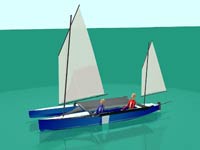 |
The vaka hull is decked to enclose the bow area back to the forward aka beam as well as the aft section behind the open crew compartment.
|
|
Ama Design
I designed the ama to be easily constructed while providing for a near optimal shape in the water. The form is very full, as well as deep in the forward sections, to put the flotation where it is needed the most. The form tapers up and away from the water as it moves aft to maintain the least amount of wetted surface for the ama as it is pressed. The ama is a high efficiency design with 100% displacement buoyancy of 800 pounds when submerged to its deck. When coupled with the length of the aka beam, the ama volume represents a considerable amount of righting force.
Most single outrigger designs will be parked with the canoe hull adjacent to another boat or dock. The ama buoyancy of the A64 allows it to be maneuvered so that the ama is right up alongside a dock and the crew can easily walk across the trampoline to go ashore.
Curved Aka Beams
There are two methods for building the aka beams. The simplest is to laminate 3mm plywood on a form with epoxy. The builder then glasses the beam, fills the weave and varnishes to high gloss to reveal the beauty of the wood beneath.
If you wanted to go all-out, you could make an easily constructed, epoxy/glass, box beam structure. The leading and trailing edges of the box beam would be further shaped in foam to give the beam an aero/hydrodynamic form as presented to the wind and waves. The entire form is then glassed for a finished beam and then painted as desired.
| The ama is a high efficiency design with 100% displacement buoyancy of 800 pounds when submerged to its deck. |
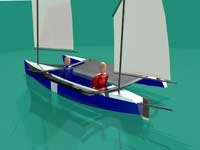
|
|
The akas attach to the canoe hull with simple cinch buckle straps much like those used to tie-down boats to roof racks. I have found this system to be extremely dependable, economical and the straps are very simple to replace if one breaks or is misplaced.
If the A64 is trailered, the ama remains mounted to the hull and only the offside, sling seat trampoline and its supporting struts are removed. Transport width for the boat in this configuration is just under 8’ and well within legal limits. This makes for an incredibly fast setup and takedown at the launch ramp. The only work involved is in stepping the rigs, mounting the rudder and attaching the offside hiking tramp.
The Rig
The base design specifies a Lug rigged yawl. The main mast will be rigged with a 70 sq. ft. sail and the mizzen will fill-out at 33 sq. ft. The Lug provides simplicity in rigging and reefing and is surprisingly powerful, stows inside the hull with ease and could also be built quickly and economically in polytarp, if the owner is so inclined
The boat has also been drawn as a 131 sq. ft. Gunter yawl if the desire for more performance is there. In fact, there are many rig configurations that could be run on this boat and I’d like to see builders experiment a bit to find the magic for their own adventures.
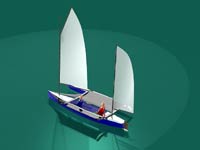 |
The boat has also been drawn as a 131 sq. ft. Gunter yawl if the desire for more performance is there.
|
|
Foils
The vaka hull will be equipped with a leeboard that is mounted to the port side of the hull. It will rotate for shallow water and be of a planform and foil section that will provide the best balance of lift and minimized drag for the sailing speeds of the boat.
Likewise, the rudder’s characteristics will match the needs of the boat’s performance and it will be able to flip-up when it contacts underwater obstacles, or is beached while down. I do this with a simple bungee on the leading edge of the rudder, well above the waterline. The bungee holds the rudder down with sufficient force to overcome water pressure while sailing, but it easily stretches, allowing the rudder to swing up and aft if the blade contacts anything more substantial.
The A64 will be very easy to build, it will be very light weight for its size and, therefore, quite easily driven in even the lightest of winds. The boat will carry a sizeable load for a very long weekend on the water. I wouldn’t be surprised at all if a couple of adventure cruisers could pack enough stuff on board for an entire week away from a source of supply.
It can be sailed comfortably in the thinnest of water and if the wind dies, this boat can be effortlessly propelled with traditional or double bladed paddles for long distances. Perhaps this isn’t a real big issue for a lot of cruising boaters, but the A64 will be capable of surprising speed under sail. That will be especially true if equipped with the larger sail rig.
| The A64 will be very easy to build, it will be very light weight for its size and, therefore, quite easily driven in even the lightest of winds. |
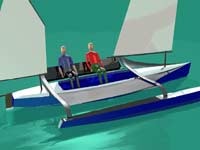
|
|
As a last little bit, to put an element of curiosity into the design package, there is a very nice folding trimaran with a comfortable solo cabin that is derived from this same hull design that I will introduce in the very near future called the A21.
Any and all comments or questions about this design or the upcoming A21 are encouraged. Plans will be available for the A64 tacking outrigger within the next two weeks after publication at Duckworks.
Chris Ostlind
Lunada Design
Chris@Wedgesail.com

Other designs by Chris Ostlind:

|